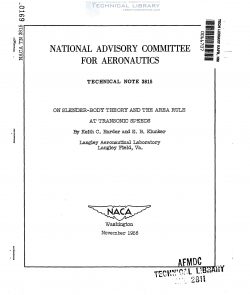naca-tn-3815
- Version
- 73 Downloads
- 608.73 KB File Size
- 1 File Count
- January 29, 2017 Create Date
- January 29, 2017 Last Updated
National Advisory Committee for Aeronautics, Technical Notes - On Slender Body Theory and the Area Rule at Transonic Speeds

The basic ideas of the slender—body approximation have been applied
to the nonlinear transonic-flow equation for the velocity potential in
order to obtain some of the essential features of slender-body theory
at transonic speeds. The results of the investigation are presented
from a unified point of view which demonstrates the similarity of slender-
body solutions in the various Mach number ranges. The primary difference
between the results in the different flow regimes is represented by a cer-
tain function which is dependent upon the body area distribution and the
stream Mach number. The transonic area rule and some conditions con-
cerning its validity follow from the analysis.
Slender-body theory originated with Munk's paper (ref. 1) in 192%
in which the forces on slender airships were calculated for low-speed
flight. In 1958 Tsien (ref. 2) pointed out that Munk‘s airship theory
also applied to the flow past inclined pointed bodies at supersonic
speeds. The subject gained new importance in l9h6 with the appearance
of Jones’s paper (ref. 5) in which it was shown that the basic ideas of
the slenderebody approximation could be used to calculate the forces on
slender lifting wings at both subsonic and supers0nic speeds provided
that pr0per account was taken of trailing-vortex sheets. Since Jones's
paper, the subject has received wide treatment. In an important paper
in 1949, ward (ref. h) developed a general unifying theory for the flow
past smooth slender pointed bodies at supersonic speeds. This theory
contains as special cases the lifting planar wings of JOnes and the slen—
der nonlifting bodies treated by Vbn Karman (ref. 5). The corresponding
problem at subsonic speeds has been examined by Adams and Sears (ref. 6)
who also extended the slender-body concepts to shapes which are "not so
slender." Lighthill (ref. 7) has given a method for calculating the
flow past bodies with discontinuities in slope. Keune (ref. 8) has
developed solutions for. slender wings with thickness, and various lifting
configurations have been treated by Eeaslet, Spreiter, Lomax, Ribner, and
others (refs. 9 to 13).
| File | Action |
|---|---|
| naca-tn-3815 On Slender Body Theory and the Area Rule at Transonic Speeds.pdf | Download |

Comment On This Post